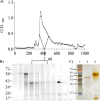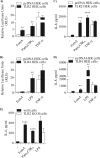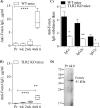The FomA porin from Fusobacterium nucleatum is a Toll-like receptor 2 agonist with immune adjuvant activity
- PMID: 22623652
- PMCID: PMC3393365
- DOI: 10.1128/CVI.00236-12
The FomA porin from Fusobacterium nucleatum is a Toll-like receptor 2 agonist with immune adjuvant activity
Abstract
Many bacterial components selectively activate immune and nonhematopoietic target cells via Toll-like receptor (TLR) signaling; modulation of such host responses defines the immune adjuvant properties of these bacterial products. For example, the outer membrane protein porins from Neisseria, Salmonella, and Shigella are known TLR2 agonists with established systemic and mucosal immune adjuvanticity. Early work indicated that the FomA porin from Fusobacterium nucleatum has immune adjuvant activity in mice. Using a purified recombinant FomA, we have verified its immune stimulatory properties and have defined a role for TLR2 signaling in its in vitro and in vivo activity. FomA induces interleukin 8 (IL-8) secretion and NF-κB-dependent luciferase activity in HEK cells expressing TLR2, IL-6 secretion, and cell surface upregulation of CD86 and major histocompatibility complex (MHC) II in primary B cells from wild-type mice, but it fails to activate cells from TLR2 knockout mice. Accordingly, the immune adjuvant activity of FomA is also TLR2 dependent. In a mouse model of immunization with ovalbumin (OVA), FomA induces enhanced production of OVA-specific IgM and IgG, including IgG1 and IgG2b antibodies, as well as enhanced secretion of IL-10 and IL-6, consistent with a Th2-type adjuvant effect. We also observe a moderate production of anti-FomA antibodies, suggesting that FomA is also immunogenic, a quality that is also TLR2 dependent. Therefore, modulation of host immune responses by FomA may be effective for targeting general host immunity not only to pathogens (as a novel TLR2 adjuvant) but also to F. nucleatum itself (as an antigen), expanding its use as a self-adjuvanted antigen in an immunization strategy against polymicrobial infections, including those by F. nucleatum.
Figures






References
-
- Akira S, Takeda K, Kaisho T. 2001. Toll-like receptors: critical proteins linking innate and acquired immunity. Nat. Immunol. 2: 675–680 - PubMed
-
- Anbazhagan V, Vijay N, Kleinschmidt JH, Marsh D. 2008. Protein-lipid interactions with Fusobacterium nucleatum major outer membrane protein FomA: spin-label EPR and polarized infrared spectroscopy. Biochemistry 47: 8414–8423 - PubMed
Publication types
MeSH terms
Substances
LinkOut - more resources
Full Text Sources
Research Materials
Miscellaneous

